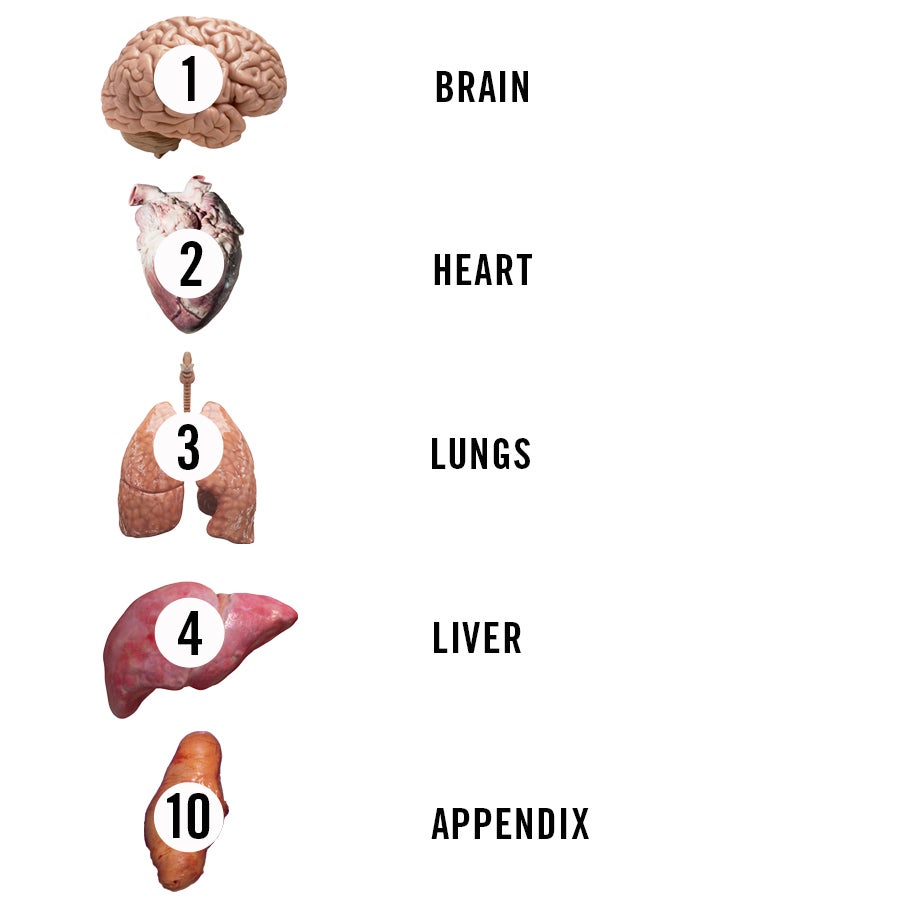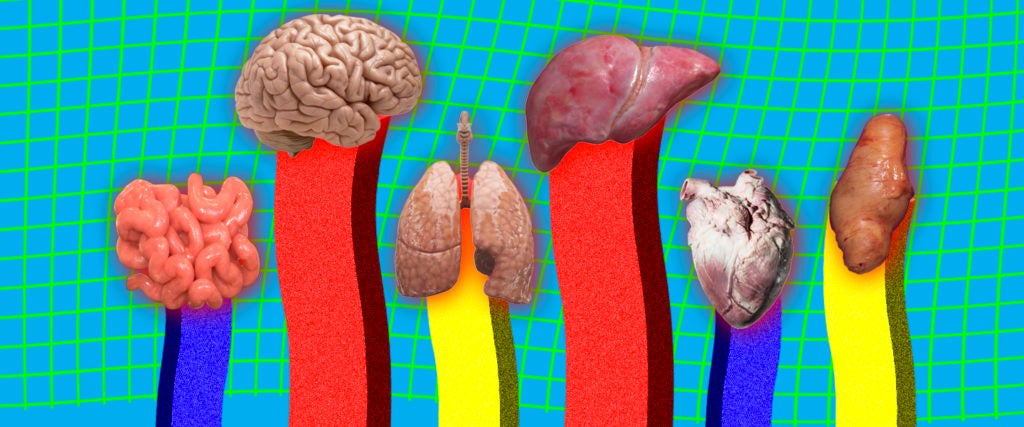When times are tough, strange thoughts cross my mind. Who are the voices in my head, and why are they so obsessed with hot dogs? How do you talk to other people again? Which organs could I sell before my body gives out?
Since I’m stuck inside my goddamn apartment with nothing better to do, let’s entertain that last question. Below, you’ll find a ranking of organs by how much you need them to stay alive, from vital to trash.
(Note that I asked a doctor to help me with this project, and all he said was, “I have 10 and need them all,” so even though you might not require all of them, hold onto your organs as best you can.)

1) Brain: Arguably the most important organ in the human body, the brain coordinates your movements, allows you to think and feel, and holds your memories — everything that makes you, well, you. Because of that, in most of the world, a person is legally dead if they permanently lose all brain activity. Thanks to medical technology, like ventilators, your body could hypothetically be kept “alive” for some amount of time without a brain, but a lack of important hormones and an inability to regulate your temperature would eventually quash anything left working, too.
2) Heart: The heart is almost as important as the brain, since it pumps blood, which carries oxygen and other important nutrients that every organ needs to stay healthy and work properly. Traditional wisdom says the brain typically suffers irreparable damage when someone goes without a heartbeat for more than 20 minutes. On the bright side, medical technology has done a better job of replacing hearts than brains: A 25-year-old from Michigan lived a whole 555 days without one at all, thanks to an artificial heart pumping in his chest.
3) Lungs: Again, lungs are pretty damn important, because they bring in the oxygen your body needs to keep running, and every cell in the body requires oxygen to live. The advantage lungs have over the heart is, well, you have two of them and can live without one. And with the help of a respirator, you can live for some time without both, so long as you have a transplant coming.
4) Liver: The liver performs more than 500 life-sustaining functions, including filtering toxins (i.e., booze) from your blood, producing digestive enzymes, storing vitamins and minerals, regulating hormones and helping blood clot. Because of all these important roles, if you experience liver failure, you can only survive for a day or two.
The liver has a pretty handy mechanism, though: You really only need part of one to stay alive — some surgeons say 25 to 30 percent of your liver is enough to maintain its normal functions — and it can grow back to full size within a matter of months. So, you can sell some of your liver… maybe.
5) Small Intestines: The small intestines are what break down food from the stomach and absorb most of the nutrients that food provides. As the American Society of Transplantation explains, “Most people can live without a stomach or large intestine, but it is harder to live without a small intestine. When all or most of the small intestine has to be removed or stops working, nutrients must be put directly into the blood stream (intravenous or IV) in liquid form.” That essentially means you need to be hooked up to a drip feeder until you can get a transplant.
6) Kidneys: Kidneys perform a few essential functions: They filter your blood, prevent the buildup of waste and extra fluid and produce hormones that help your body regulate its blood pressure, produce red blood cells and some other stuff, too. The good thing about kidneys is, it’s entirely possible to live a perfectly healthy life with just one. And even if you lose both, you can be put on dialysis, which draws waste out of the body, and recent research shows someone placed on dialysis at age 20 can expect to live for 16 to 18 years. It’s very far from ideal, but a lot longer than you’d live without a heart or brain.
7) Stomach (and Large Intestines, aka Colon): As the American Society of Transplantation so kindly mentioned earlier, people can live without a stomach, despite how miserable that may sound. It’s sometimes surgically removed as a result of cancer or trauma — a teen in England, for example, had to have hers taken out after drinking a cocktail laced with liquid nitrogen — then the surgeons attach the oesophagus directly to the small intestines. If all goes well, you can eat a normal diet, accompanied by some supplements.
8) Spleen: The spleen plays a part in your immune response: It stores and recycles red blood cells, and houses white ones. However, the spleen is fairly commonly removed as a result of trauma, and you can live comfortably without it, since the liver does a fine job of recycling red blood cells, and other parts of the lymphatic system are able to take over any immune functions that the spleen was previously handling.
9) Gallbladder: The gallbladder stores bile, a fluid produced by the liver that helps break down fatty foods. But too much cholesterol in that bile can produce gallstones, which cause all sorts of pain and internal trouble. Therefore, it’s pretty common for people to bid farewell to their gallbladder, through a procedure called a cholecystectomy, and go on to live a totally normal life.
10) Appendix: The appendix is a trash organ, because it almost only serves to hurt you. It’s believed to be a “safe house” for good bacteria of the bowel, but it’s quite prone to become inflamed when intestinal contents get trapped in there, which can result in appendicitis. This is why people have their appendix removed all the time and notice virtually no difference to their life, except less pain. And even then, if it’s not fully removed, problems with the appendix can come back and cause trouble all over again. So screw you, appendix.
Honorable Mention: While you can certainly live without your D or V — one study even suggests that men who’ve had their testicles removed live longer, arguing that “male sex hormones decrease the lifespan of men” — only you can decide whether that’s a life worth living.
Welp, my brain’s now telling me to go have a hot dog. See ya.

